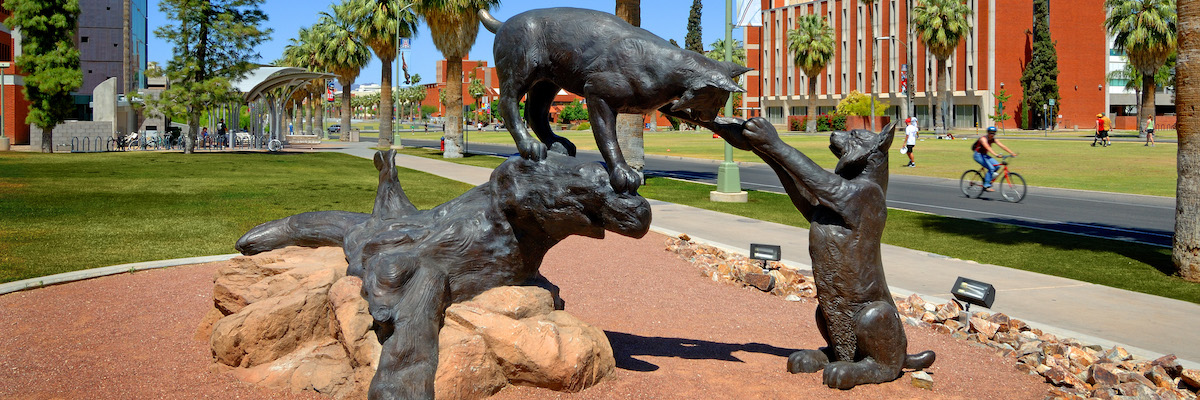New Investigator Checklist
Congratulations and welcome! Now that you've been hired, there are several key steps you can take before you arrive on campus to help expedite the establishment of your research program. With proper advance preparation, you can even submit research proposals prior to your arrival.
-
- Find out who the department business manager and/or research administrator is in your department or college. Schedule a phone meeting with him or her to discuss pre-hire action items and setting up your research program. Topics you should discuss include:
- Designated Campus Colleague (DCC) pre-hire status
- NetID Account
- NetID+ (Plus) authentication and the UA Virtual Private Network (VPN)
- UA system provisioning
- Details of your start-up funding, including any restrictions and expiration dates.
- Overall research group budget
- Space (lab and/or office) design or redesign
- Equipment purchasing or use of shared equipment via Core Facilities
- Lab supplies
- New hires - graduate students, postdocs, lab managers
- Familiarize yourself with HR policies and their resources for new employees, including the New Employee Checklist, hiring (recruitment, relocation, employee orientation, Faculty Affairs' New Faculty Orientation
- Once you have DCC status, watch the PI Orientation Video Course
- Many materials and systems require approval from Research Laboratory & Safety Services:
- Biological Materials
- Hazardous Chemicals (including Controlled Substances)
- Lasers (class 3b and 4)
- Radioactive Materials
- Radiation Generating Devices
- Occupational Health services are provided based on the potential hazard exposures in your lab.
- If you do human subjects research, contact the Human Subjects Protection Program.
- If you do animal research, contact the Animal Welfare Program.
- If you already have animals that you need to transfer, reach out to University Animal Care as early as possible.
- Consider the following resources when establishing your lab:
- “Career Trends: Running Your Lab,” Science
- “The Faculty Series: Setting Up Your Own Lab,” NatureJobs blog
- Reach out to UA's Research Laboratory & Safety Services
- Find out who the department business manager and/or research administrator is in your department or college. Schedule a phone meeting with him or her to discuss pre-hire action items and setting up your research program. Topics you should discuss include:
- Identify your onsite faculty mentor(s). Many departments offer formal mentoring programs. Some ideas for discussion:
- Department culture and ways to engage
- Identify areas for research collaborations
- Develop your five-year research plan, for advice on how to do this, The Professor Is In shares tips including identification of specific writing project deadlines (including deadlines for completion, submission, and revision); academic calendar deadlines; major conferences with submission deadlines for abstracts and proposals; major funding deadlines (including large/small grants and the prep needed to successfully apply for those grants); and submission dates for honors and awards
- Develop your teaching skills, including engagement of undergraduates in research (for tips on how to do this go to the Office of Societal Impact)
- If you are in the biomedical sciences, the NIH National Research Mentoring Network can help you connect with colleagues across the country.
- Find opportunities for mentorship outside your department through the GIDP or Arizona Biological and Biomedical Sciences (ABBS).
- A good read is Ellen Ensher and Susan Murphy’s Power Mentoring: How Successful Mentors and Proteges Get the Most out of Their Relationships. You can also watch Dr. Ensher’s TEDx Talk at her website.
- Look at the calendar of research-related workshops and seminars.
If you are transferring from another institution:
- Work with the institution you are leaving to initiate the process of relinquishing your grants to the UA.
- Consider contacting the Institutional Animal Care and Use Committee (IACUC) and the Human Subjects Protection Program for assistance.
- Contact Sponsored Projects Services for assistance transferring your equipment.
Pro Tip: Share great news! And share when you need some help.
Arriving to campus and kicking off the semester will result in a flurry of activity. Fortunately, the UA has a number of experienced professionals to help assist you with your research goals. If you are research active (or want to be), here's a list of things you can do to get up and running as quickly as possible.
- Stay informed of research-related activities on campus by signing up for listservs and newsletters
- The Current — a weekly distribution highlighting research-related activities, events, announcements, and curated funding opportunities in PIVOT
- Limited Submissions — a weekly distribution of upcoming and open limited submission opportunities
- IRB — regulatory updates related to human subjects research
- RAMTALK — research administration updates
- Other resources with research-related listservs include Postdoctoral Affairs and the Graduate College's Office of Fellowships & Community Engagement
- Reach out to the research compliance programs and laboratory safety services that are relevant for your area of research and begin the process of acquiring any necessary approvals.
- As an Investigator, you are required to comply with the University’s Conflicts of Interest & Commitment Policy. Make it a priority to complete the brief required online training so you understand your responsibilities under the policy, and submit your first disclosure via the University's eDisclosure system. As a first step, you can also contact the Office of Responsible Outside Interests for assistance.
- Work with your business manager if you require specific building or lab access. Keyless entry is generally done with your CatCard or with an issued physical key through the Key Desk.
- Mentors: Set up your first face-to-face meeting(s) with your mentor(s). See guidance in the Pre-Hire section.
- Most colleges have an Associate Dean for Research (ADR); reach out to them with your plans and to learn about any resources that may be useful to you.
- Get to know the research administrators and/or business manager in your department or college. Ask them to walk you through the process for drafting and submitting proposals, and to highlight any relevant college/department-level processes and policies.
- Familiarize yourself with institutional proposal submission requirements:
- Proposal development timelines
- UAccess Research (UAR) routing and college/department specifics
- UA’s Limited Submission process — Often sponsors limit the number of proposals an institution can submit to a particular solicitation. Learn about how the selections are made at UA.
- Many sponsors require you to have an individual login to develop proposals. Sponsored Projects Services (SPS) can provide guidance and support in creating your user account or affiliating an existing profile with UA (FastLane, eRA Commons, etc.)
- The UA’s Research Development Services (RDS) provides faculty support through proposal review, opportunity identification, and collaboration across campus.
- UA provides a funding database to all faculty, students, and staff. We suggest you sign up, claim your profile, and start using PIVOT to become familiar with funding opportunities in your area.
- Join Accountability Writing groups or Moderated Proposal-Specific Groups (e.g., CAREER, NEH Fellowships, R01)
- If you need access to shared research facilities to conduct your research, get acquainted with Core Research Facilities and High Performance Computing services.
- Browse the University’s Library system.
- Set up your lab and office by purchasing equipment, installing equipment, working with UITS for computing services.
- Social media active? Follow UArizona Research on Twitter, Facebook, Instagram, and YouTube.
- A few additional resources:
- New Faculty Guide to Competing for Research Funding by Mike Cronan and Lucy Deckard, Academic Research Funding Strategies, LLC (requires UA NetID to access)
- Academic Research Funding Strategies, LLC, “Development & Grantwriting News” monthly newsletters available through the RDS Catalog (requires UA NetID to access)
If you are transferring from another institution:
- For commercializing your invention or discovery, visit Tech Launch Arizona.
- Interested in collaborating with public and private partners, entrepreneurs, and investors? Reach out to Corporate Engagement Services.
- The UA Foundation's GIFT Center and Foundation Relations team can support your efforts in developing philanthropic relationships.
Pro Tip: The first semester can seem extremely overwhelming. Identify ways to preserve some work-life balance, whether it’s setting “on” hours for checking email, working remotely, or simply closing your door. For more, see UA’s Life & Work Connections.
As you move into your second semester on campus, we suggest setting specific goals and taking steps to operationalize your research program.
- Start by writing or updating your five-year research plan. The plan should include:
- key research ideas that you’d like to focus on,
- a list of target professional conferences for attendance and for presentations,
- your target publications,
- identification of complementary expertise needed to accomplish your goals (to help you identify collaborators), and
- a list of funding opportunities that fit these goals.
- Review the UA tenure and promotion policies and procedures.
- Focus on identifying and building research collaborations. One way to do this is to connect with a UA Research Center or Institute.
- Consider Internal Seed Funding Opportunities.
- Work with your business office to recruit grad students, postdocs, and a lab manager or technician for your team.
- Consider this resource from Howard Hughes Medical Institute (HHMI): Making the Right Moves: A Practical Guide to Scientific Management for Postdocs and New Faculty, Second Edition.
- The Office of Instruction & Assessment provides support with pedagogical planning and more.
- Join a faculty learning community (FLC).
- If you haven’t already, now’s the time to establish a writing routine.
- As a new faculty member, once you’ve become familiar with campus culture and federally-sponsored research, consider reaching out to the other support units on campus:
Pro Tip: Establish a writing routine. In his book How to Write a Lot, Paul J. Silvia says one of the most important career steps an academic can take is to develop a writing routine. Set aside time, preferably daily, where you turn off all distractions and write.
Subscribe to the UArizona Impact in Action newsletter to receive featured stories and event info to connect you with UArizona's research, innovation, entrepreneurial ventures, and societal impacts.




